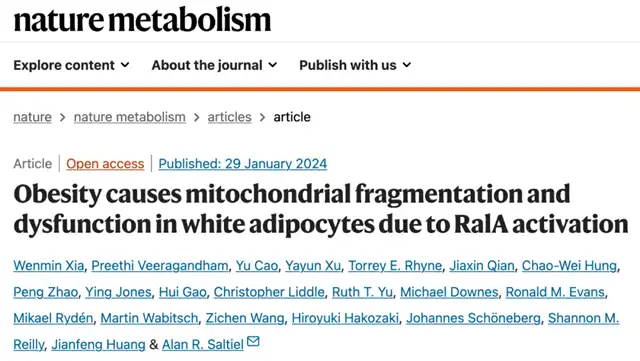Unlocking Weight Loss: Targeting a Single Gene to Combat Obesity
- Normal Liver Cells Found to Promote Cancer Metastasis to the Liver
- Nearly 80% Complete Remission: Breakthrough in ADC Anti-Tumor Treatment
- Vaccination Against Common Diseases May Prevent Dementia!
- New Alzheimer’s Disease (AD) Diagnosis and Staging Criteria
- Breakthrough in Alzheimer’s Disease: New Nasal Spray Halts Cognitive Decline by Targeting Toxic Protein
- Can the Tap Water at the Paris Olympics be Drunk Directly?
Unlocking Weight Loss: Targeting a Single Gene to Combat Obesity
- Should China be held legally responsible for the US’s $18 trillion COVID losses?
- CT Radiation Exposure Linked to Blood Cancer in Children and Adolescents
- FDA has mandated a top-level black box warning for all marketed CAR-T therapies
- Can people with high blood pressure eat peanuts?
- What is the difference between dopamine and dobutamine?
- How long can the patient live after heart stent surgery?
Unlocking Weight Loss: Targeting a Single Gene to Combat Obesity
Removing a Single Gene Could Prevent Obesity, Boosting the Development of Novel Weight Loss Therapies
In today’s society, obesity has become a global epidemic, significantly increasing the incidence of diseases such as type 2 diabetes, non-alcoholic fatty liver disease, cardiovascular diseases, and even elevating the risk of cancer. A recent study covering 243 cities in China with 15.8 million adults revealed alarming statistics: 34.8% of the population is overweight and 14.1% are classified as obese, highlighting a grave situation.
Diet, exercise, and other lifestyle factors play crucial roles in the development of obesity, with metabolism being a key focus. Scientists have observed a close relationship between obesity and metabolic abnormalities, such as mitochondrial dysfunction. Therefore, uncovering the intrinsic connection between obesity and metabolism—specifically, a crucial gene—could fundamentally curb obesity, bringing joy to the world of overweight individuals.
On January 29, 2024, researchers from the University of California, San Diego, published a study titled “Obesity causes mitochondrial fragmentation and dysfunction in white adipocytes due to RalA activation” in Nature Metabolism.
The study found that feeding mice a high-fat diet leads to smaller mitochondria within their fat cells, resulting in reduced fat burning capacity. This process is controlled by a gene called RalA, and deleting this gene prevents mice from becoming obese even when fed a high-fat diet. This discovery brings humanity one step closer to developing targeted therapies that increase fat burning to address weight gain and related metabolic dysfunctions.

High-fat diets lead to excessive calorie intake and fat accumulation in the body, paving the way for obesity and its complications. During the development of obesity, white adipose tissue (WAT) undergoes metabolic changes characterized by hormone insensitivity, inflammation, fibrosis, and apoptosis.
It’s worth noting that mitochondrial dysfunction is a key feature of obesity, insulin resistance, and fatty liver disease. Mitochondria play a crucial metabolic role in healthy adipose tissue, but in obese individuals, mitochondrial function is impaired. In this scenario, the ability of fat cells to burn energy diminishes, contributing to the difficulty in losing weight for obese individuals. However, what causes mitochondrial damage and how it leads to obesity and other complications remains unknown.
To answer this question, Professor Alan Saltiel’s team meticulously studied the connection between obesity and mitochondria in fat cells. They fed mice a high-fat diet to induce obesity and measured the impact of this dietary pattern on mitochondrial function in white adipose cells. They found that excessive fat intake led to abnormal mitochondrial division in the white adipose tissue of mice—resulting in many smaller, ineffective mitochondria—leading to reduced oxidative capacity and stalled fat consumption, further exacerbating obesity.
Further research revealed that this metabolic effect is driven by the activity of a molecule called RalA. RalA is a small GTPase whose expression and activity increase in the white adipose cells of mice fed a high-fat diet (HFD). RalA has many functions, including aiding in the breakdown of mitochondria when they malfunction. When this molecule is overly active, it disrupts normal mitochondrial function, leading to metabolic issues associated with obesity.
Therefore, chronic activation of RalA plays a critical role in suppressing energy expenditure in white adipose tissue, shifting mitochondrial dynamics towards excessive division, resulting in metabolic dysfunction and excessive weight gain.
As confirmation, the research team generated RalA knockout mice, which were resistant to obesity induced by a high-fat diet. Morphological observations of mitochondria indicated that knocking out RalA could reverse the increased fission of mitochondria in white adipose cells induced by a high-fat diet. Interestingly, some proteins influenced by RaIA in mice resemble those in humans associated with obesity and insulin resistance, suggesting similar mechanisms exist in humans leading to obesity.
In conclusion, this study published in the journal Nature Metabolism demonstrates that high-fat diets induce obesity and its complications by triggering abnormal mitochondrial division, with chronic activation of RalA playing a key role in this process. This discovery brings humanity one step closer to developing targeted therapies that increase fat burning to address weight gain and related metabolic dysfunctions.
Unlocking Weight Loss: Targeting a Single Gene to Combat Obesity
Link to the paper: https://www.nature.com/articles/s42255-024-00978-0
(source:internet, reference only)
Disclaimer of medicaltrend.org
Important Note: The information provided is for informational purposes only and should not be considered as medical advice.



